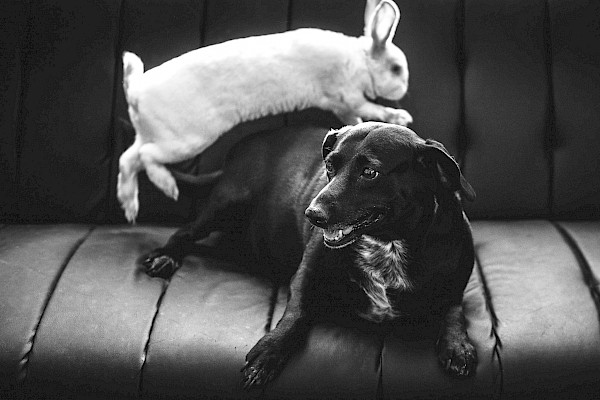Desicions
Do you always plan a spring clean in the spring? Do you clean the windows first, or the kitchen? Do you first get the garden into shape, or do you start by tidying up the house? Or maybe you’ve decided against a spring clean?
We make decisions every day – around 20,000 per day, or so it is estimated. Of course, most of them are small things, so we almost or entirely automatically make them based on our experiences. That’s why we are often not even aware that we’re making decisions in these moments. Butter or margarine on my breakfast toast? Tea or coffee? What should I wear? Cycle to work, or take the bus? Sport or a film to relax in the evening? What am I going to cook…? Beside such minor decisions, there are always times in which we face big decisions – and we need to make them! Do I want to change my job? Which course should I choose? Do I want to start a relationship, or not?
How do you make such decisions? Are you maybe the sort of person who listens to their gut, or do you prefer to try and make decisions with your head? In this article, we’d like to show you how we humans make decisions, explain why we sometimes find decision-making very hard and tell you what special techniques there are to support you in the decision-making process – among other things!
What are decisions?
In principle, a decision is nothing more than a choice between options. To make a decision, you need at least two options to choose between. It is, of course, possible, that the options are already fixed (e.g., a menu in a restaurant) or you might need to compile them yourself (e.g., possible employers when job-hunting). Decisions are affected by events (situations and facts) that cannot be influenced by the person making the decision. When you decide for one option, this choice will also have consequences, which may arise directly but could also be delayed. Decisions are mostly made on the basis of the anticipated consequences.
People’s goals and motives are factors that guide the decision-making process. If, for example, you want to do more sport after work (goal), this will limit your options for your decision, in the sense that you exclude options such as watching TV and meeting friends in favour of a possible choice of jogging, swimming or cycling. As the decision mostly concerns the future, it is always associated with a degree of uncertainty. You cannot possibly predict the future with 100% accuracy. This means that we sometimes prefer to postpone making decisions, or avoid them altogether. More about this later.
In general, we are convinced that we make most decisions consciously, after considering them and focussing on the goal. But actually, we are very often influenced by various different factors.
Rules of thumb (heuristics) and distortion errors
For many decisions, particularly more complex decisions, we fall back on rules of thumb, or heuristics. In many cases, heuristics lead us to the correct or approximately right decisions or judgements. Rules of thumb are applied spontaneously and intuitively. This means that you have already made a judgement before you actively need to think about it. When you do this, you will mostly also have the feeling that you have made the right call and that this feeling is also accurate. That is the case in many situations, but under certain circumstances it may lead us to systematic errors of judgement.
The following heuristic was defined by Tversky and Kahneman:
- Anchoring heuristic
If you have to answer a question, but don’t have a clue what the correct answer is, then you set an anchor and use this to derive your answer. For example, if you are asked for the number of inhabitants of a city you don’t know, you take as an anchor another city whose population numbers you do know. You will then automatically adjust your answer to your anchor. Consequently, the correctness of your answer will depend on the correctness of your anchor. We also set ourselves such anchors subconsciously. - Availability heuristic
When we need to estimate the likelihood of a certain risk (e.g., earthquakes, illness), we tend to consider how well we know that risk. If many of the people around you, or even you yourself, are affected, you will estimate the risk as much higher than it actually is. We think in terms of: “if I can easily think of an event, then it must happen a lot” or “if it’s easy for me to imagine an event, then obviously it occurs often”. - Representative heuristic (similarity heuristic)
If, for example, you have to say what the probability is that Person A is a basketball player, your answer will depend on how closely Person A matches the cliché of a basketball player. You reach a judgement even though you have no information about the person other than their external appearance.
A multitude of mistakes and false assumptions unconsciously influence our ability to make judgements and decisions. Our lives and our environments are highly complex, and it was and is necessary for our brains to develop such rules of thumb so we can handle them well. It is important that you are aware that your assumptions are not necessarily always correct and that it’s worth questioning certain things from time to time.
Why do we often find it difficult to make decisions?
When we make a decision, we say “yes” to one option and “no” to one or several others. We commit ourselves and take a position. But committing ourselves is something that many of us are scared of. It could be that, with hindsight, a decision doesn’t turn out in the way we hoped. Maybe there is even a risk that your decision will trigger a social conflict? Nobody wants to make mistakes and frequently, the dominant expectation is that we will find the perfect solution. But precisely that is never going to happen. There is no perfect decision, because we ourselves are not perfect and neither is our environment. What’s more, the future cannot be perfectly predicted either, however much we wish it could.
Another aspect that hampers decision-making is that the pain of losing is greater than the joy of winning. If you choose something, that means that you have simultaneously decided against the advantages of the other option and for the disadvantages of your chosen option. So your decision always means a certain loss too. If you aspire to make perfect decisions, such facts might tempt you to postpone decision-making or even to avoid it entirely.
We find decisions particularly difficult when the options are almost the same. Seen rationally, you could simply toss a coin in such a situation, and let chance decide; after all, the options are practically identical anyway. However, the problem is not that the options differ in the quantitative sense, rather that they differ qualitatively. Rational approaches are often not very helpful for such decisions. So can you generally make better decisions based on your own gut instinct?
Gut or head?
Emotions and feelings cannot be disregarded today, not even when it comes to making decisions. However, this wasn’t always the case. Before the 1990s, feelings were considered a disruptive influence on the rational, cognitive decision-making process. How much influence emotions have on decision-making is demonstrated by, for example, the famous case of Phineas Gage, a foreman from England. In an accident at work, an iron rod two metres long and six kilogrammes in weight pierced his skull (from the left cheek to the front of the cranium). Despite all expectations, he survived the accident and was considered recovered after a few months. Yet Phineas Gage was no longer the same. There were huge changes in his personality. His emotional life degenerated and so did his social behaviour. Above all, however, he was no longer able to make decisions. True, he could think about things more intensively and map out the exact advantages and disadvantages, but choosing one option and putting it into practice was something he could no longer do.
Emotions supply us with the information for making fast decisions and identifying relevant aspects, among other things. Consequently, intuitive decision-making processes are no less valuable than rational techniques. To put it another way, you need both gut and head to make a good decision. In certain situations it is sensible, even advantageous, to listen to your gut first and foremost, for example, when the decision situation is complex and unmanageable, or if you already have extensive experience, or if decisions need to be made extremely rapidly (e.g., in sport). When you go with your gut like this, it is hard to explain, justify or defend your own choice. Ultimately, it just feels good and right. That’s part of it, and is completely normal – you need both your head and your gut. Unfortunately there is no recipe for making decisions. Below we will tell you about some techniques that may help you.
What can help us to make decisions?
Are you the sort of person who writes down the advantages and disadvantages of the possible options before making the decision? A lot of people do this. They hope to obtain a clear picture at the end and, best case scenario, a solution for their decision. But does this really work? When you try this, do you ever get the feeling that you might have listed some important aspects, but that they really can’t be compared? For example, when you’re job-hunting and want to compare two options with each other. You’d earn more with option A but the field of activity is more exciting for option B. What do you do now? It’s not an easy question. One technique (a decision matrix) suggested in the literature as a rational way of reaching decisions works by making you think first and foremost about your wishes and needs, rather than beginning with the different options. What is really important to you? What is your goal? What are you afraid of and what do you absolutely want to avoid?
After this first step, in which you have noted your goal criteria, you now need to evaluate them. How important are they to you? Rate them on a scale of 0 to 5 (step 2). A rating of 0 always means “not at all important” and 5 “extremely important”. In the third step, gather all the options you think worth considering. When you’re job-hunting, that will be all possible employers. When you have all your potential options in one place, you then also rate these from 0 to 5 with regard to how closely they meet your goal criteria (step 4). The next step consists of multiplying the ratings for your goal criteria from step 2 with the fulfilment grades of your options from step 4. In the final step, you calculate the numbers for each option and obtain a total for each that is now comparable with all the other options. Seen rationally, you should then choose the option with the highest rating. Pretty complicated, right? You’re not entirely wrong. The video below explains this method using an example. For the rating, it uses a scale from 1-10, not 1-5, but this gives the same result.
Rational techniques like this are suitable only when the decision problem is clearly structured. Can my goals and options be clearly defined? Can I assess the weighting meaningfully or do I maybe lack the experience to correctly estimate the fulfilment grade, for example? If you can’t answer these questions with an unequivocal “yes”, then intuitive or creative techniques may well be more suitable.
Intuitive techniques
Is this situation familiar? You’ve written down the criteria for what you want in your new flat. Then you go to a flat viewing and feel very comfortable there. You want to take the flat, although it doesn’t rationally meet your specified criteria. Situations like this often occur. Research has shown that intuitively feeling comfortable may result in a good decision that makes us happy. In such cases, intuition (unconscious motives, experiences, considerations) has already made a sort of preliminary decision. Creating a pros-and-cons list for all options is then only one more aid to help you justify or defend, to yourself and others, the decision you have already made. Maybe you will actually consciously adapt your list, strike out certain points or rate them differently, so they fit better with your intuition.
Your brain works round the clock. Even if you are not consciously thinking about the decision you have to make, the information about it is being processed by your subconscious. It makes a great deal of sense to consciously occupy yourself with other things during a decision-making process, to make some space for this subconscious information-processing. Allow the decision to sink in subconsciously for a while. As the famous piece of advice suggests: sleep on it!
Creative techniques
When you make a decision, you are dealing with yourself. What do I want? What do I not want? What requirements must be considered? Very different questions will need to be clarified during the process before you can make a satisfactory decision. If you have no experience in a particular area, your intuition won’t be able to help you very much. That’s when creative techniques may support you. Likewise, there are many different methods for these techniques, such as De Bono’s six thinking hats technique. In this technique, the hats each represent a different perspective. The method was actually developed for groups in which each person has to argue in favour of one of these perspectives; however, it also works when you're on your own, but you have to play all the roles, one after another. You can make each role easier by actually wearing a different hat for each one. The hats represent the following perspectives:
- Opportunity-oriented, optimistic thinking (Advantages? Opportunities?)
- Critical, pessimistic thinking (Disadvantages? Problems? Difficulties?)
- Analytic, information-based thinking (data, facts, details)
- Intuitive thinking (opinions, emotions, perceptions, personal)
- Creative thinking (new ideas, unusual approaches)
- Coherent thinking (control, order)
This role-play will help you to collect information impartially.
Another technique that we’d like to introduce you to is the Worst-Case-Best-Case meth-od. This technique is suitable when you don’t know how the option will evolve after you have chosen it. So you create three specific scenarios for possible consequences:
- Worst Case
• If you choose this option, what would be the worst possible outcome?
• What indicates that it will happen?
• Can you prevent it with your own behaviour, or influence it?
• What factors can you not control? And how have these factors appeared in the past or in similar situations? - Best Case
• What would be the best possible outcome?
• What indicates that it will happen?
• Can you guide or influence the outcome yourself?
• What factors can you not control and how have these factors appeared in the past or in similar situations? - Realistic Case
• You can now develop this case from the above two scenarios by contrasting them with each other. Reality will probably turn out to be less ex-treme than in scenarios one and two, and consequently more like to be true.
Of course, all the techniques listed here have advantages and disadvantages. They can help you to make the decision, but they won’t make it for you.
“Any decision is better than none. You can only learn from your mistakes.”
- Britta Steffen -
How do I deal with bad decisions?
In general it is important that mistakes are no longer taboo. Handling them openly and constructively is necessary to prevent consequences such as postponing or shuffling off decisions and covering up bad decisions. If you have made a bad decision, it is crucial that you address it. Only in this way can you prevent the entirely natural reaction of denying your mistakes. What’s more, this is the only way of learning from your mistakes and developing innovative solutions for them. Take enough time and make sure you deal with the emotions you experience too. How did you feel? How do you still feel? What are the consequences of your bad decision, and can they possibly be compensated for? What can you do better the next time you have to make a decision?
It is helpful to talk to other people about both reaching a decision and addressing a bad decision.
Conclusion and tips
- There are no perfect decisions! Even if you are unsure about, or even afraid of, any possible consequences, don’t be deterred from making decisions. Just note that uncertainty is an inevitable part of decision-making. The vast majority of decisions can be undone and you can learn from bad decisions and grow.
- If you feel overwhelmed in a situation with many possible options, you can make your decision according to habit, minimise the options by excluding some, or even content yourself with the first option that meets your criteria (this stops you from endlessly attempting to optimise your choice).
- Discuss your decision-making process with others. This will give you different perspectives.
- Consider what you do not want. Maybe you can already exclude some options this way.
- Make decisions calmly and don’t rush. For example, sleep on them.
“Wise decisions are decisions for which head, gut, mind and emotions are coordinated.”
- Maja Storch -
References
Harzheim, C. (2019, 10 October). Tschüss, mein ewiger Jein-Sager. Beobachter Gesund-heit. https://www.beobachter.ch/gesundheit/psychologie/entscheidung-treffen-tschuss-mein-ewiger-jein-sager
Jungermann, H., Pfister, H.-R., & Fischer, K. (2005): Die Psychologie der Entscheidung – Eine Einführung. https://www.zhaw.ch/de/psychologie/dienstleistung/sportpsychologie-mentaltraining/mentaltraining-laufsport/entscheiden/
Kahneman, D. (2003). A perspective on judgment and choice: mapping bounded rationali-ty. American Psychologist, 58(9), 697–720. https://doi.org/10.1037/0003-066X.58.9.697
Kahneman, D. (2011). Thinking, Fast and Slow. Macmillan.
Pfister, H. R., Jungermann, H., & Fischer, K. (2017). Die Psychologie der Entscheidung. Springer.
Salewski, B. (2021, 5 July). Entscheidungen treffen - Zweifel überwinden. BR Fernsehen. https://www.br.de/br-fernsehen/sendungen/wir-in-bayern/service/entscheidungen-treffen-zweifel-ueberwinden-familientherapeutin-birgit-salewski-102.html
Sauerland, M., & Gewehr, P. (2017). Entscheidungen erfolgreich treffen: Entscheidungskompetenzen aufbauen und die Angst vor Fehlentscheidungen abbauen. Springer.
Werth, L., Denzler, M., & Mayer, J. (2020). Sozialpsychologie – Das Individuum im sozialen Kontext (2 Ed.). Springer. https://doi.org/10.1007/978-3-662-53897-5
 subscribe to newsletter
subscribe to newsletter


